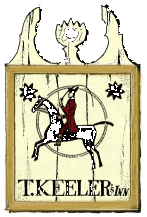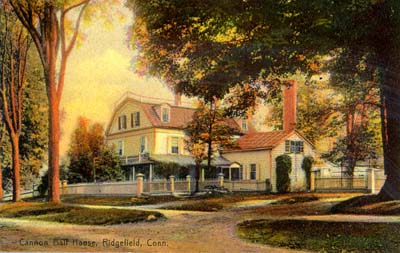History of Ridgefield & Keeler Tavern
 "The
little town that time forgot," is an appropriate description of Ridgefield,
a town that still closely attempts to hold onto its colonial heritage.
Ridgefield was established in 1709, encompassing Branchville, Titicus, &
Ridgebury.
"The
little town that time forgot," is an appropriate description of Ridgefield,
a town that still closely attempts to hold onto its colonial heritage.
Ridgefield was established in 1709, encompassing Branchville, Titicus, &
Ridgebury.
As late as the 1960s it felt as though you were taking a step back in time
when you entered Ridgefield. Turning left onto the historic Main Street, at the
historic horse trough, traveling among the large elm and oak trees, it was
apparent as you drove past the Colonial houses that this was not just another
community. You had entered a town that was still unique, in spite of its
proximity to the hustle and bustle of New York City. The town population of
22,000 stabilized in 1972.
Ridgefield is the site of the Revolutionary War 1777 "Battle of
Ridgefield." American Generals Wooster and Arnold attempted to hold off the
British in the only land battle on Connecticut soil during the Revolution. There
are still monuments and markers to the events or incidents that transpired in
that 1777 battle. They remind us that Ridgefield has a heritage that must be
preserved. The Revolutionary Road historical project is currently being
developed. When it is completed it will aid all of us in helping to uncover the
treasures of Ridgefield, its history, and its patriots. Ridgefield is one of
Connecticut's finest treasures. The town is the perfect blend of New England
small town charm, combined with Americana's modern day tastes.
Now almost 30 years later, there has been a transformation in the town. While
it still retains much of the charm of yesteryear, the landmark building are
sandwiched between the "modern" day improvements that must necessarily
become a part of any modern, growing community.
Some folks say, "To live there is to love it…" It is true. Those
who live in Ridgefield love it and there is a community commitment to keeping it
at the top. Town officials and residents alike, strive toward creating the
perfect balance of yesterday's charm with today's enrichment.
Credits: www.ridgefieldct.org
|
|
|
The Benjamin Hoyt Home built in 1713, now known as Keeler Tavern & Gilbert Gardens
|
THE SECRET GARDEN AT KEELER TAVERN
BY JEANNETTE ROSS
Good things come in small packages, and that is as true for gardens as it
is for other things. "This is one of the best-kept secrets in Ridgefield,"
said Pat Stephens, president of the Keeler Tavern Museum on Main Street.
She was referring to the garden behind the museum building. It is one of
the public gardens listed in the Garden Conservancy Open Days Directory.
Keeler Tavern began its life, most likely, as a simple two-room home built
in the early 18th century by Benjamin Hoyt in 1713. The tavern that played
a role in the Battle of Ridgefield in 1777 and still bears the scar of a
cannon ball in its corner post. Restored rooms furnished in Colonial style
with volunteers attired for the period. Timothy Keeler purchased it in 1769,
by which time it had been expanded in size. In 1772 the building began its
long career as an inn and tavern, a regular stop on the coach route between
New York and Boston. The tavern, which eventually turned into a hotel, remained
in the hands of the Keeler family until 1907.
By that time, Ridgefield had become a popular summer community, and the renowned
architect Cass Gilbert bought the building and property from Anna Marie Ressiguie,
Timothy Keeler’s granddaughter. A Neo-Classicist, Mr. Gilbert designed the
Supreme Court Building in Washington, D.C., and the Woolworth Building in
New York City. He also designed Ridgefield’s fountain, which he gave as a
gift to the town.
The Gilberts were great entertainers, Mrs. Stephens said, and in 1915 Mr.
Gilbert designed and built the Garden House, behind the museum. It was the
site of many lavish parties. Mr. Gilbert also designed the garden, known
as a Charleston garden, for his wife, Julia Finch Gilbert, a great lover
of roses.
Today, the garden evokes the elegance, not the excesses, of that grand pre-depression
era. Steps lead from the stately garden house to the sunken garden. Its remaining
three sides are bordered by arched brick walls. Growing up the sides are
clematis and New Dawn pillar roses, which bloom continuously through the
warm months. One corner holds wildflowers — trilliums, jack-in-the-pulpit,
and others. More than 100 varieties of annuals and perennials are planted
throughout and bloom into the fall.
The garden is maintained by the Caudatowa Garden Club of Ridgefield. While
the club has remained faithful to the use of roses, Sandra Dickinson, Caudatowa
president, said other plants are different from what the Gilberts may have
known. Over the years the garden’s appearance changed. It was even a vegetable
garden at one time, she said.
"We try to use new and unusual flowers to create interest for ourselves and
the public," Mrs. Dickinson said, adding that the flowers are not identified
because they change places from season to season. "We lean to the old-fashioned
to make it look old English with a romantic feeling."
One thing that hasn’t changed is the reflecting pond with its cherub fountain.
The pond is filled only for special events at the museum, but it still adds
a serene quality to the spot.
Mr. Gilbert left few references to the garden behind, and so it is not an
historically correct garden. "We worked with the general bones of the garden,"
Mrs. Dickinson said, saying by the time members got to it in the late 60's
it was all overgrown with no flowers at all.
But the essence of the garden — the walls, the pond, and the handsome brick
walkways — was still in place. It proved to be enough. The club won a silver
bowl from National Federation of Garden Clubs a few years ago for its work
on reconstructing the garden, working from a plan designed by White Flower
Farm in 1968 or '69.
It’s hard to believe such a peaceful place can exist a few feet from the
thrumming of cars up and down Main Street. But it does. The garden is open
daily from dawn to dusk. For information, call the museum at 203-438-5485.
u
The Garden Conservancy is a non-profit organization in Cold Spring, N.Y.,
dedicated to the conservation of private and public gardens for the future.
One way the group does this is through its Open Days program.
http://www.acorn-online.com/home805e.htm
Email: John E. Hoyt
 "The
little town that time forgot," is an appropriate description of Ridgefield,
a town that still closely attempts to hold onto its colonial heritage.
Ridgefield was established in 1709, encompassing Branchville, Titicus, &
Ridgebury.
"The
little town that time forgot," is an appropriate description of Ridgefield,
a town that still closely attempts to hold onto its colonial heritage.
Ridgefield was established in 1709, encompassing Branchville, Titicus, &
Ridgebury.